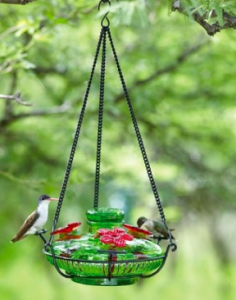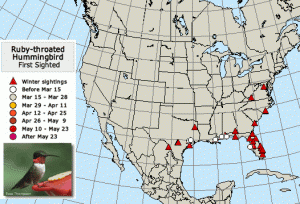Boiled Hummingbird Feeders?

One of the plastic hummingbird feeders was looking a bit cloudy, although it was cleaned prior to storing last season. While making the first batch of nectar (so simple-recipe below) I had the brilliant idea to pour some of the boiling water in the feeder to “clear it up”. The feeder proceeded to melt in my hand… I couldn’t grasp what was happening at first, until I ended up with a Salvador Dali-looking hummingbird feeder! Really should have taken a picture, but was too disappointed in my better judgement. The feeder’s usable for now, but it sure does look funky.
This is exactly why we prefer blown glass or ceramic hummingbird feeders over plastic ones. The quality just can’t be compared. Instead of buying a new feeder every other season, handcrafted hummingbir
Here’s a map showing the first sightings for Ruby Throats in the South and Southeast, with some who’ve even wintered up North. Brave little guys… it won’t be long now! Find the really easy nectar recipe to fill your hummingbird feeders below, they like it better than commercial mixes too 🙂
Mix 1 cup plain table sugar to 4 cups water. NOTHING ELSE, no substitutes as they may be harmful or even fatal to hummingbirds. Plain, Pure Cane Sugar is the only ingredient to use for nectar. No red dye either, it’s a big myth! There’s no need to boil the water, as any organisms spread are by the hummingbirds’ beaks. We do boil one cup of water, simply to dissolve the sugar more effectively. Let cool, fill feeders, and store unused nectar in the fridge for up to two weeks. That’s it! If you’ve never made your own nectar, we encourage you to try it this season, hummingbirds seem to prefer it, and it will be the least expensive bird food all year!

